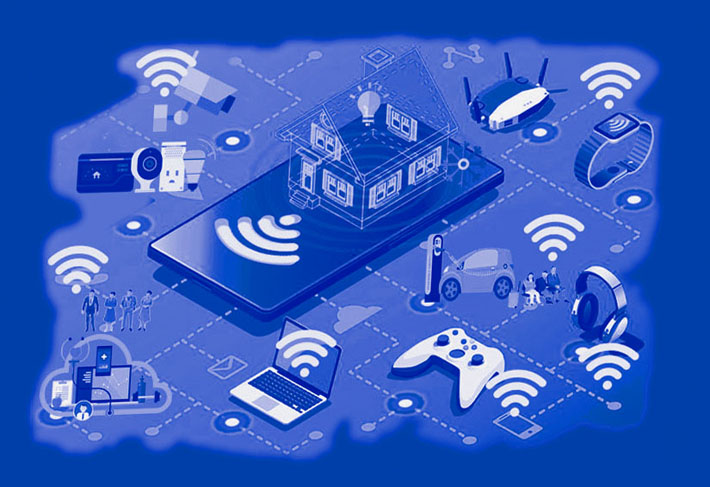Wi-Fi technology
Not long ago, a computer was connected to the Internet and a local network only via a wired connection. Today, instead of wires, Wi-Fi transmits information via radio waves. The range is not limited to a small apartment. Seamless Wi-Fi systems allow you to connect several buildings, both residential and commercial, into a wireless network. In addition, a parabolic antenna or WiFi gun can receive a Wireless Fidelity signal from a distance of several miles. Digital data streams are transmitted via radio channels in the ranges of 2412 MHz - 2472 MHz, 5160 MHz - 5825 MHz, 5955 MHz - 7115 MHz.
Comparison of Wi-Fi and Bluetooth
Unlike Bluetooth, wireless Wi-Fi technology is not used for direct connection of devices, but for access to various networks, including the Internet. A Bluetooth wireless network can also connect nearby devices into a local network, but a Wi-Fi network will be better in most respects in similar conditions. IEEE 802.11 a/b/g/n/ac/ax wireless technology offers greater bandwidth and a greater range than a Bluetooth wireless network. At the same time, Bluetooth LE wireless technology and its modifications is capable of providing a significant signal transmission range with minimal power consumption. Wi-Fi drivers are usually already installed, but Bluetooth download for PC with Windows 11, 10, 8, 7 and even XP operating system from the site https://www.bluetooth.today/en/downloads is required additionally. Wi-Fi technology, by splitting the signal into parts, transmits packets over different radio frequencies. This makes it possible to transmit large amounts of information at high speed. The https://wirelesstechnology.site website is dedicated to wireless technologies and devices for industry, agriculture, services, and home use.
Wi-Fi Applications
Wireless Wi-Fi technology is used when it is impractical to pull a cable or there is simply no technical possibility. High data transfer speed and bandwidth allow even a dozen different devices from different manufacturers to work with one router simultaneously. You can use the Wi-Fi network and the Internet from any device compatible with the IEEE 802.11 standard. It is important to ensure minimal impact from household appliances that produce radio waves.

IEEE 802.11 a/b/g/n/ac/ax modules are installed not only in desktop computers, laptops, netbooks, tablets, smartphones, printers, scanners, MFPs, but also in washing machines, air conditioners, refrigerators and other smart kitchen appliances and smart dishes, as well as smart home systems, alarms, control and many other devices. Wi-Fi networks can be found everywhere: in transport, residential buildings, offices, enterprises, retail outlets and entertainment centers, catering establishments, pharmacies and hospitals, on the streets, in parks and other places.
Wi-Fi characteristics of a modern router
Wi-Fi wireless data transmission technology has already gone through 7 generations. A number of the most important characteristics of the Wi-Fi standard are constantly being improved: base frequency, channel width, coding methods. To buy a good Wi-Fi router, it is enough to understand a few numbers and letters on its label.
The speed class reflects the maximum theoretical throughput of the device and is determined by the IEEE standard as it increases from 802.11n of the fourth to 802.11be of the seventh generation: 802.11n, 802.11ac, 802.11ax, 802.11be. Each frequency is a separate network of 2.4 GHz, 5 GHz and 6 GHz: Wi-Fi 5 - 5 GHz, Wi-Fi 6 - 2.4/5 GHz, Wi-Fi 6e - 2.4/5/6 GHz. In real work, the speeds are added up at all router frequencies, but sometimes
when switching only to 2.4 GHz, the connection becomes more stable. Wi-Fi channels can have a width of 20/40/80/160/320 MHz. With an increase in the channel width, the volume of transmitted information increases, but the working distance decreases due to increased interference.
Multiple Input and Multiple Output technology creates spatial streams through multiplexing. Wi-Fi routers are equipped with several antennas, for example SU-MIMO 2x2 means that two antennas are used for receiving and two for transmitting data. This theoretically doubles the throughput. MU-MIMO 16x16 can distribute all 16 streams to one device, or divide them into several participants. Everything is simple here - the more, the faster.
During transmission, data is encoded using quadrature modulation (QAM). The higher the modulation level, the denser the data is transmitted and the higher the maximum speed. When the noise level increases, the modulation moves to a lower level. If the interference level drops, the modulation switches to the next higher level: 16-QAM, 64-QAM, 256-QAM, 1024-QAM, 4096-QAM. Naturally, 16-QAM is slower than 4096-QAM, but is more resistant to interference.
Thus, to buy a good Wi-Fi router, it is enough to find the following letters and numbers on its label: 802.11 ax/be, 2.4/5/6 GHz, 160/320 MHz, 4096-QAM, Wi-Fi 6e/7 and the logo of a famous brand.
Advanced Wi-Fi standards
Two advanced Wi-Fi standards - Qualcomm AllPlay and Miracast - are designed to transmit 24-bit/192 kHz audio and high-quality HD video with almost no loss. Japanese wireless technology WirelessHD works with FullHD video and 7:1 audio (24-bit/96 kHz), Dolby TrueHD (24-bit/192 kHz), DTS-HD. AirPlay 2 technology from Apple is compatible with many models of audio and video branded equipment Apple, Marantz, Denon, and others. The Play-Fi standard is designed to work with many platforms as a universal alternative to AirPlay. The advantages of Play-Fi include: interaction with various devices, minimal loss of sound quality, broadcasting streaming audio from the Internet. Sonos wireless technology based on Wi-Fi of the same brand provides control of acoustics in different rooms from any smartphone with the Sonos application. Large equipment manufacturers (Bose, LG, Samsung and others) have analogs of similar technologies based on Wi-Fi and Bluetooth. Wireless Audio Video Bridging technology provides high-quality synchronization of sound on several speakers in different parts of the house better than all competitors.

